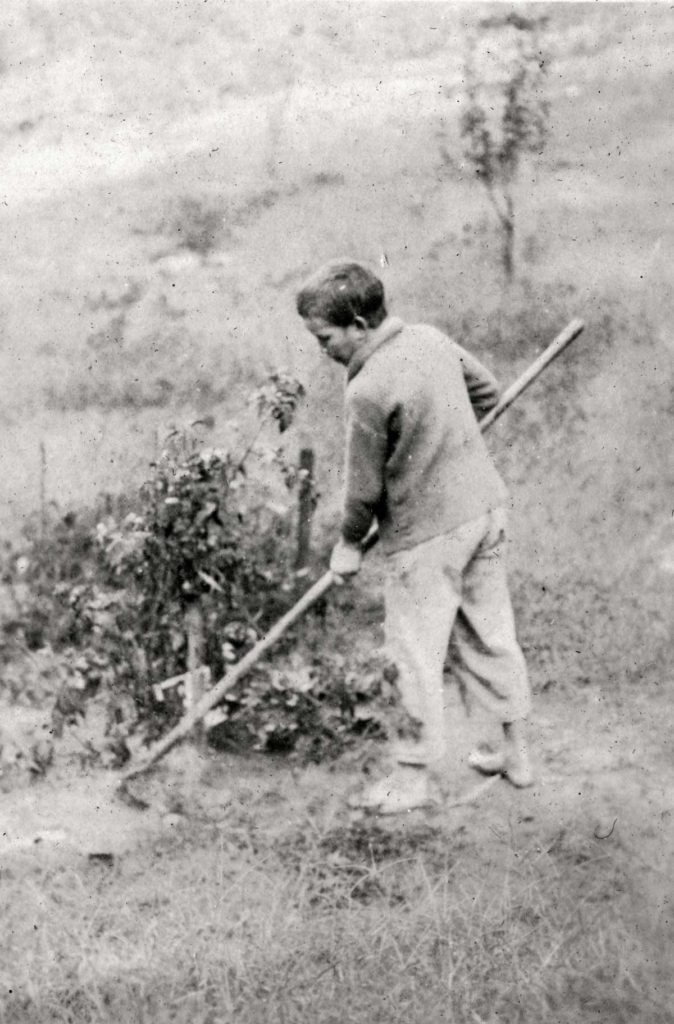Pine Mountain Settlement School
Series 11: FARM
Farm History and Teaching Philosophy
1914-1918

A child hoes a garden. [melv_II_album_019x.jpg]
FARM History 1914-1918
TAGS: farm history, 1914-1918, farms, farming, Pine Mountain Settlement School, Harlan County, Kentucky, ditching, drainage, fruit trees, berry bushes, grapes, cow-peas, rye, beans, apples, corn, cabbage, hogs, Mary Rockwell Hook, Katherine Pettit, industrial education
“While the school has been a-building Miss Pettit and our farmer have accomplished titanic tasks on the farm.“
From the beginning in 1913, the founders believed that education was comprised of “head, hand, and heart.” Of the two co-founders, Miss Katherine Pettit must be seen as the director of “hand” education — the industrial side of the educational model. Even in their earliest years students were enlisted to participate in all aspects of campus life, including the agricultural endeavors, as excerpts from this letter demonstrate.
A report of the School’s progress details Katherine Pettit’s educational accomplishments of maintaining the land.
While the school has been a-building Miss Pettit and our farmer have accomplished titanic tasks on the farm. Four-thousand feet of box-ditching drain the land, and a large portion of it has been fenced away from the efforts of that intrepid citizen-at-large, the hog. Besides fruit trees, berry bushes and grapevines have been set out, and four acres have been cleared for orchard. A disc harrow, lime sprinkling, cow peas and rye are turning neglected fields into garden land. Daily our family of thirty-three is fed on homegrown vegetables and we are putting away for winter cabbage, beans, apples, and corn .…
You would really believe that this is an industrial school if you could see what our children are learning as they help us in these tasks. Watermelons scientifically planted by children from six to nine years old; sweet potato vines transplanted by a brood of the same age; young fruit trees set out by little girls, with the greatest care for their roots: these are real lessons in agriculture …
Although we are pioneers we have tried to keep in mind not only present needs but a future ideal. Expert agriculturalists, orchardists, civil and hydraulic engineers, and builders visited us in the first few months and freely gave us expert advice. Miss Mary Rockwell (Hook), our architect, has been with us twice and insists that we grow according to a plan, not only to achieve convenient grouping for our buildings, but also to preserve the enchanting natural beauty of our grounds …Assets:
Letter to Friends, 1914. (Excerpts)
125 acres recently given. (Mostly coal and timber.) A coal bank. A limestone cliff.
A boundary of timber aggregating 600,000 ft.
A stone quarry.
A maple sugar grove.
Annual pledges to the amount of $1600.00.
An unpolluted water supply.
Three dwelling houses.
One tool house.
Two sanitary closets.
Sawmill.
Two mules.
One hog and two more chickens.
Two collie pups, promised.
SEE ALSO:
DANCING IN THE CABBAGE PATCH Farming the Land Early Years 1913-1930
DANCING IN THE CABBAGE PATCH Farm and Dairy Years I
FARM Agriculture Correspondence 1917-1918
FARM – Farm & Farming Overview
FARM and FARMING Guide
FARM Guide to Resources
FARM Lime Kiln Processing
COMMUNITY Fair Day 1914-1915 Farmer’s Meetings
WELLS RECORD 08 PMSS Farm Dairy Poultry
RECORD Pine Mountain Settlement School 03 – 1914-1915
EVELYN K. WELLS 1915 Excerpts From Letters Home
PUBLICATIONS PMSS Brochure 1915 PMSS Appeal to Annual Subscribers
PUBLICATIONS Brochure 1915 Pine Mountain Settlement School in the Making
MARGUERITE BUTLER Letters 1915

